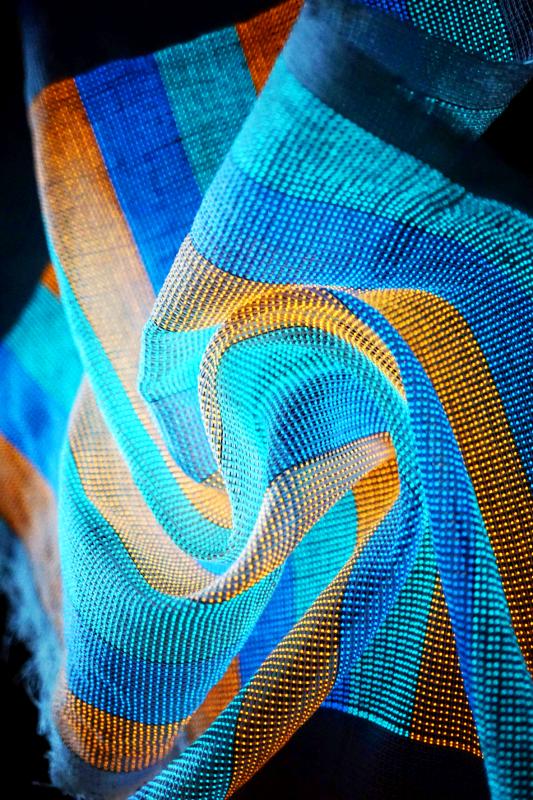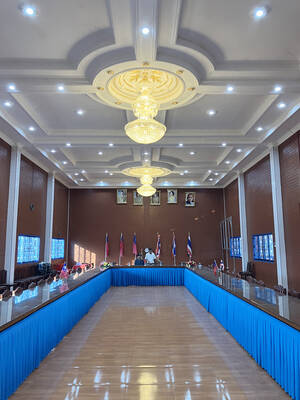At first glance, the fabric looks like a pretty if not especially original scarf, with turquoise, blue and orange stripes in an open weave. But this fabric can communicate.
It’s wearable, foldable and washable, but it’s also a fully functioning display — capable of flashing messages or images, or even being used with a keyboard.
The fabric, described in a study in the journal Nature on Wednesday, is the work of a team led by Peng Huisheng (彭惠生), a professor in the department of macromolecular engineering at Shanghai’s Fudan University.

Photo: AFP
He believes it could revolutionize communication and “help individuals with voice, speech or language difficulties to express themselves to others.”
“We hope that woven-fiber materials will shape next-generation electronics by changing the way we interact with electronic devices,” he said.
Wearable electronics have advanced significantly in recent years, and clothing incorporating electronic functions including super-thin displays is already available.

Photo: AFP
Another study published this week, for example, describes a wearable microgrid powered by the sweat of the wearer.
But there are limitations to most existing products.
They are often made by attaching or weaving thin film light-emitting devices to fabrics, resulting in a material that is not breathable or very flexible.
They are also often fragile and prone to damage, and in the past were only able to display pre-determined patterns.
WARP AND WEFT
Peng and his colleagues have spent a decade thinking about ways to improve existing technology, experimenting with different materials.
One option they formulated did not display well in the dark, while another fiber they came up with did not perform when it was woven.
The breakthrough came after examining the structure of textiles and the way threads intersect with each other in the warp and weft of a woven piece.
The team decided to try to create minuscule points of light where the fibers of a woven cloth meet.
To make these tiny dots of light, they needed a luminescent warp and a conductive weft that could be woven together with cotton or similar fibers.
After testing different combinations, they settled on a silver-plated yarn warp coated with luminescent composite, and a conductive weft spun from a kind of gel.
The two materials were woven with cotton into a piece of fabric six meters long and 25 centimeters wide.
Applying an electrical current caused the layer on the silver-plated yarn to light up where it was in contact with the conductive gel fiber.
The amount of power needed to light up the display material was limited, producing no significant heating, the authors say, and the fabric survived a number of stress tests.
It was left in the open air for a month, put through 100 wash-and-dry cycles and folded 10,000 times, all without losing brightness.
LANGUAGE BARRIERS
The study says the fabric can be powered with batteries or even use solar energy.
But what purpose might it serve?
Peng sees a variety of options, including a dynamic sleeve display that could, for example, allow a driver to view a GPS map on their arm as they move around.
But he is hopeful the material could also help people overcome difficulty communicating because of health problems or language barriers.
In one experiment with the fabric, they collected brainwaves from volunteers who had either been playing a race car game or meditating — simulating a person in a stressed or relaxed state.
When paired with a processor, the waves could then be translated into messages displayed on the fabric reading either “relaxed” or “anxious.”
Peng said there were several improvements to the fabric the team would now work on, including making the display brighter, the resolution clearer, and the luminescent points available in more colors.

Taiwan Power Co (Taipower, 台電) and the New Taipei City Government in May last year agreed to allow the activation of a spent fuel storage facility for the Jinshan Nuclear Power Plant in Shihmen District (石門). The deal ended eleven years of legal wrangling. According to the Taipower announcement, the city government engaged in repeated delays, failing to approve water and soil conservation plans. Taipower said at the time that plans for another dry storage facility for the Guosheng Nuclear Power Plant in New Taipei City’s Wanli District (萬里) remained stuck in legal limbo. Later that year an agreement was reached

What does the Taiwan People’s Party (TPP) in the Huang Kuo-chang (黃國昌) era stand for? What sets it apart from their allies, the Chinese Nationalist Party (KMT)? With some shifts in tone and emphasis, the KMT’s stances have not changed significantly since the late 2000s and the era of former president Ma Ying-jeou (馬英九). The Democratic Progressive Party’s (DPP) current platform formed in the mid-2010s under the guidance of Tsai Ing-wen (蔡英文), and current President William Lai (賴清德) campaigned on continuity. Though their ideological stances may be a bit stale, they have the advantage of being broadly understood by the voters.

In a high-rise office building in Taipei’s government district, the primary agency for maintaining links to Thailand’s 108 Yunnan villages — which are home to a population of around 200,000 descendants of the Chinese Nationalist Party (KMT) armies stranded in Thailand following the Chinese Civil War — is the Overseas Community Affairs Council (OCAC). Established in China in 1926, the OCAC was born of a mandate to support Chinese education, culture and economic development in far flung Chinese diaspora communities, which, especially in southeast Asia, had underwritten the military insurgencies against the Qing Dynasty that led to the founding of

Artifacts found at archeological sites in France and Spain along the Bay of Biscay shoreline show that humans have been crafting tools from whale bones since more than 20,000 years ago, illustrating anew the resourcefulness of prehistoric people. The tools, primarily hunting implements such as projectile points, were fashioned from the bones of at least five species of large whales, the researchers said. Bones from sperm whales were the most abundant, followed by fin whales, gray whales, right or bowhead whales — two species indistinguishable with the analytical method used in the study — and blue whales. With seafaring capabilities by humans